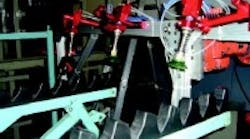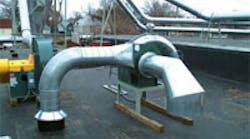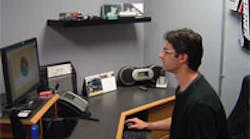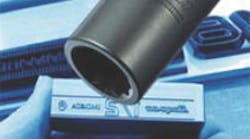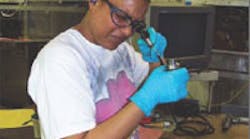Material-handling suction cups at DaimlerChrysler.
As part of a DaimlerChrysler Summer Intern Professors Program, Dr. Kingman Yee, an associate professor of mechanical engineering at Lawrence Technological University in Southfield, Mich., did a comparative study of vacuum technologies used in material-handling processes. He found that the automaker could increase productivity and significantly reduce costs at its plants in Michigan by decreasing air consumption, reducing downtime and improving the cycle times of robots and other equipment that use suction cups to lift and transport parts.
As part of his study, Yee tested Coax multistage ejector technology from Piab USA Inc. (www.piab.com) that integrates the internal components of a multistage vacuum pump into a vacuum cartridge to transform them into efficient and flexible systems.
In comparisons with other vacuum ejectors and suction cups, Yee found that the Coax vacuum generators used 1.1 scfm of compressed air per cycle, as much as 78 percent less than single-stage vacuum generators. In addition, he found that adding a check valve to the Coax system would reduce the consumption of compressed air by 98 percent.
The check valves shut off the supply of compressed air when the correct suction is reached and turn the vacuum back on if the level drops because of leakage.
Yee's results showed that DaimlerChrysler had the potential to reduce the cost of electricity used to produce compressed air for one suction cup to 56 cents per year, based on electricity costs of 7 cents per kilowatt hour. That compares to costs of about $61.66 per year for other systems. A typical automotive stamping plant that uses 2,000 suction cups in materialhandling systems could save $122,200 per year, based on Yee's study. If DaimlerChrysler replaced outdated systems, Yee estimated that the company could realize an annual savings of $418,300 at a typical stamping plant.
The modular construction used in the Coax multistage ejector technology Yee used in his study allows for quick and easy maintenance, repair and replacement for vacuum system components.
Yee says the performance of multistage ejectors is critical to achieving the savings he estimated. The Coax systems reach evacuation flow rates of 85 scfh and generate holding forces of 100 pounds. That, according to Yee, is about 25 percent higher than other systems and translates into improved reaction in the suction cups, faster processing cycles and increased productivity.
